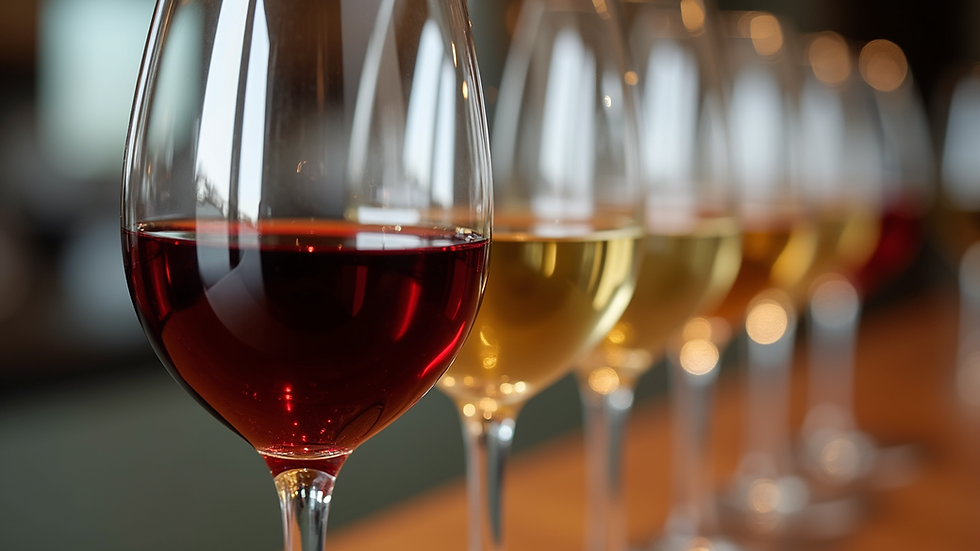Uncorking the Mystery: What Secrets Does Your Next Wine Tasting Hold
- MYRIAM DANDONNEAU
- May 30
- 4 min read
Wine tasting is more than just sipping from a glass; it's an art form that reveals the flavors, aromas, and stories found in each bottle. Whether you’re a wine lover or just curious, the experience offers a delightful journey through taste and culture. So, what secrets await at your next wine tasting? Let's explore and uncover the joy that each glass can bring.
The Basics of Wine Tasting
Wine tasting involves evaluating the subtleties of wine to appreciate its full profile. Each detail of the wine contributes to its story. To begin, observe the wine’s appearance: hold the glass against a white background to see its true hue.
Next, swirl the wine gently in your glass. This helps release aromatic compounds. Take a moment to inhale deeply. What aromas do you detect? You might find fruity scents like peach or raspberry, earthy notes like mushroom, or floral hints like jasmine.
Now, it’s time for the tasting. Take a small sip and let it roll around in your mouth to experience its full essence. Consider the initial flavors, the mid-palate sensations, and the lingering finish. For instance, a bold Cabernet Sauvignon may start with berry notes, shift to earthy undertones, and finish with hints of spice.
The Importance of the Right Glassware
Wondering if the wine glass matters? Absolutely! The shape of the glass impacts how aromas and flavors are perceived. Bordeaux glasses, for example, have a larger bowl, allowing fuller-bodied reds to breathe and reveal their complexity. In contrast, narrow glasses suit delicate whites like Riesling or Sauvignon Blanc.
Using proper glassware enhances the tasting experience, showing respect for the wine. It communicates that you're committed to savoring each drop.
Exploring Different Varietals
Each wine varietal brings a unique story shaped by grape type, growing region, and weather. For example, a Chablis is a Chardonnay from Burgundy, France, known for its mineral notes and crisp acidity. Regions like Napa Valley yield bold Zinfandels that embody fruit-forward flavors thanks to the warm sunshine.
At tastings, consider sampling a variety of wines. You could explore a light Pinot Grigio alongside a rich Merlot, helping you identify your preferences. According to the Wine Institute, consumers are increasingly interested in trying different varietals, with 38% of wine drinkers expressing a desire to explore new and unique options.
Pairing Wine with Food
Many wine tastings feature food pairings, which can elevate both the wine and the dish. The classic guideline is to match light wines with lighter foods and fuller wines with heartier dishes. For instance, a fruity Pinot Noir pairs beautifully with roasted salmon, while a bold Malbec complements a grilled barbecue brisket.
Do not hesitate to experiment during tastings. The aim is to discover exciting combinations that surprise your palate. A recent survey by Wine Spectator found that more than 70% of participants enjoyed trying new wine and food pairings at tastings.
The Role of Terroir
Terroir refers to the specific environmental conditions where the grapes are grown, including soil type, climate, and topography. The terroir significantly influences the flavors and characteristics of the wine produced.
At a tasting, engage your host by asking about the terroir of the wines you sample. For example, wines from volcanic soils may have unique mineral qualities, while those from cooler climates often exhibit bright acidity and fruitiness. Knowing the terroir adds depth to your tasting experience.
Pay Attention to the Language of Wine
Wine tasting has a special vocabulary that may seem daunting. Understanding terms like “tannins,” “body,” “acidity,” and “finish” can enhance your experience.
Tannins: Compounds from grape skins and seeds that create a drying sensation in red wines, often prevalent in Cabernet Sauvignon.
Body: Indicates the wine’s weight in your mouth; a light-bodied wine feels like skim milk, while a full-bodied wine feels like cream.
Acidity: This gives wine its crispness and balance, helping freshen up heavier dishes.
Finish: Refers to how long the taste lingers on your palate after swallowing. A wine with a long finish, like a mature Cabernet, can leave a lasting impression.
Familiarizing yourself with this language can deepen your appreciation of each glass.
The Social Aspect of Wine Tasting
Wine tastings are often social events where friends and family gather to share stories and enjoy flavors together. Whether in a vineyard, a wine shop, or your backyard, tastings foster memorable experiences.
Some wine schools offer classes that blend social interaction with education, a fun way to meet others while learning. Engaging with fellow wine lovers can enhance your understanding and enjoyment.
What to Expect After the Tasting
When the tasting wraps up, do not rush to leave. Take time to chat with fellow enthusiasts or the host. Ask about the wines you've tried, their favorites, and recommendations for future selections. If one wine especially caught your attention, inquire if they have it available for purchase or shipping.
You might just find a new favorite to add to your collection, enriching your wine journey.
Savor the Adventure
Wine tasting is a journey filled with exploration, education, and enjoyment. By engaging with the experiences surrounding it, you open up a world of flavors and connections.
So, the next time you uncork a bottle, consider attending a tasting event. Remember, it's not just about the wine; it’s about the stories, the people, and the experiences that make wine tasting special. Cheers to discovering secrets at your next wine outing!

Enjoy the moment, and let your wine journey unfold beautifully!

















Comments